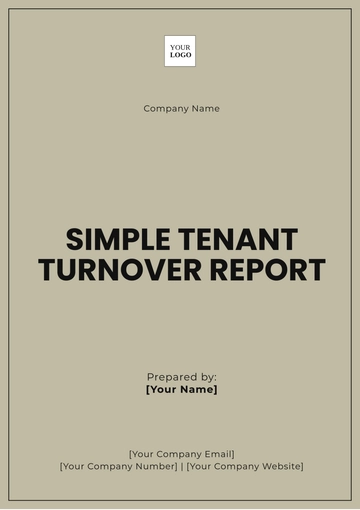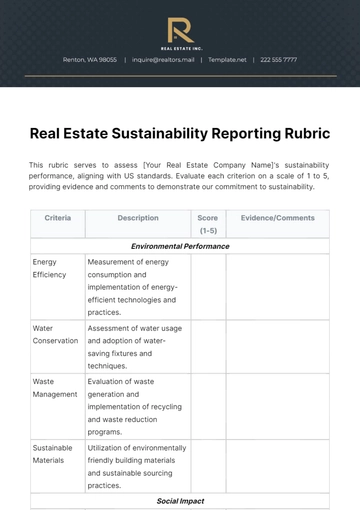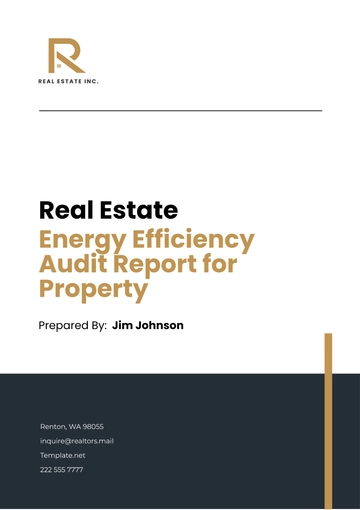Free Real Estate Property Condition Report

Executive Summary
This in-depth report evaluates the current state of the real estate portfolio owned by [YOUR COMPANY NAME]. The focus is on identifying necessary maintenance and upgrades essential for enhancing or preserving the value of each property. The condition of a property not only influences its market price but also affects client interest and the overall value of the asset. This document aims to equip [YOUR COMPANY NAME] with detailed, current insights into its property investments, providing a strategic foundation for future planning and investment decisions. By systematically assessing each property's condition, this report outlines a clear path towards optimizing the portfolio's performance and value.
I. Introduction
The comprehensive nature of this report is designed to give [YOUR COMPANY NAME] a detailed overview of its real estate holdings, covering an array of crucial aspects. Through an exhaustive analysis of the physical state, required repairs, projected expenses, and additional pertinent information, the report aims to deliver a holistic view of the current standing and potential of each managed property. The objective is to ensure that [YOUR COMPANY NAME] is fully informed about the conditions of its assets, enabling informed decision-making regarding property management, investment strategies, and future growth.
II. Methodology
The assessment methodology is thorough and multifaceted, incorporating physical inspections, architectural evaluations, and mechanical/electrical infrastructure reviews of each property. Site visits are conducted by experienced inspectors who assess the structural integrity, systems functionality, and overall aesthetics of the properties. Architectural reviews consider the design and layout effectiveness, compliance with current building codes, and potential for enhancements. Mechanical and electrical systems are scrutinized for efficiency, safety, and reliability. Data collected from these assessments are meticulously recorded, analyzed, and synthesized into this comprehensive report. This method ensures a broad yet detailed understanding of each property’s condition and needs, serving as a reliable basis for the recommendations provided.
III. Property Details
Below is a summary table of the key details of each property within [YOUR COMPANY NAME]'s portfolio. This table serves as an at-a-glance overview, presenting essential information such as property identification, location, year built, type, and current market value. This consolidated view facilitates a clear understanding of the portfolio's diversity and value distribution, setting the stage for the in-depth condition summaries that follow.
Property ID | Address | Year Built | Type | Current Value ($) |
|---|---|---|---|---|
1 | 1234 Sample St. | 2050 | Residential | 250,000 |
2 | 5678 Example Ave. | 2047 | Commercial | 350,000 |
3 | 91011 Test Blvd. | 2040 | Residential | 325,000 |
4 | 1213 Dummy Rd. | 2042 | Commercial | 450,000 |
5 | 1415 Placeholder Ln. | 2041 | Residential | 500,000 |
IV. Property Condition Summary
The comprehensive evaluation of [YOUR COMPANY NAME]'s property portfolio reveals various conditions across the spectrum of assets, necessitating a strategic approach to maintenance, repairs, and upgrades. This summary distills the findings from meticulous onsite inspections, categorizing them into actionable segments to prioritize efforts and investments effectively. Understanding the nature and urgency of each issue is crucial for maintaining the properties' value and functionality.
Immediate Repair/Replacement
Issues classified under immediate repair or replacement are those posing direct and significant threats to the structural integrity, safety, or operational functionality of the properties. These may include compromised foundation elements, critical roof damage, severe water intrusion, or malfunctioning critical systems (e.g., heating, ventilation, and air conditioning (HVAC), electrical, and plumbing systems) that require urgent attention to prevent imminent deterioration or hazard. Addressing these concerns promptly ensures the safety of occupants and preserves the property's marketability and value. For example, a compromised roof on Property ID 2 demands immediate action to prevent water damage to interior spaces and structural components.
Short-term Repair/Replacement
This category encompasses issues that, while not immediately critical, could escalate into significant problems, causing considerable damage if left unaddressed within the next year. Examples include aging HVAC systems that are near the end of their operational lifespan, minor roof repairs, early signs of water damage or mold, and exterior maintenance such as siding repairs or window replacements. Proactively managing these repairs can prevent larger, more costly issues down the line. Property ID 3's HVAC system, nearing its service life end, falls into this category, requiring planning for replacement to ensure continuous, efficient operation.
Long-term Repair/Replacement
Long-term repair/replacement issues are those that, if not addressed within the next five years, could lead to substantial disruptions or necessitate more extensive repairs. This category often includes planned upgrades to systems nearing the end of their expected lifespan, addressing less critical structural wear and tear, and making improvements for energy efficiency or compliance with new regulations. For instance, Property ID 4 could benefit from updating its electrical system to accommodate increased loads and modern, energy-efficient appliances.
At Will Repairs
At will repairs refer to non-critical issues that do not presently compromise the property's integrity or operational aspects but may need to be addressed to enhance aesthetics, functionality, or efficiency. These repairs or upgrades can be scheduled based on budget availability, strategic planning, or tenant preferences. They might include cosmetic updates, landscaping improvements, or optional system upgrades. Property ID 5, for example, might consider updating its interior design elements and exterior paint to boost curb appeal and tenant satisfaction without immediate urgency.
No Repairs Necessary
Properties or sections thereof falling into the 'No Repairs Necessary' category are in good condition, reflecting either recent updates and maintenance or a lack of any significant wear and tear. These areas should continue to be monitored through regular maintenance checks to maintain their status. This designation does not imply a lack of need for routine care but rather indicates that no additional major interventions are required at the time of reporting. Property ID 1's newly renovated sections exemplify this category, where recent upgrades have mitigated the need for further immediate action.
Prioritization and Planning
This categorized approach to property condition assessment facilitates strategic planning for maintenance and capital improvements across [YOUR COMPANY NAME]'s portfolio. By prioritizing immediate and short-term repairs, the company can allocate resources efficiently, mitigate risks, and plan for the future. This proactive strategy not only preserves the structural and operational integrity of each property but also optimizes the return on investment by maintaining high standards of functionality, safety, and aesthetics, ensuring sustained property value and market competitiveness
V. Conclusion
This Property Condition Report lays a solid foundation for prioritizing the maintenance, repair, and upgrade needs across [YOUR COMPANY NAME]'s real estate portfolio. By adhering to the recommendations detailed within, the company can significantly enhance its assets' value and appeal, ensuring both sustained client satisfaction and asset performance. This strategic approach to property management will support [YOUR COMPANY NAME] in achieving its operational and financial objectives, reinforcing its position in the real estate market.
Prepared by: [YOUR NAME]
For: [YOUR COMPANY NAME]
- 100% Customizable, free editor
- Access 1 Million+ Templates, photo’s & graphics
- Download or share as a template
- Click and replace photos, graphics, text, backgrounds
- Resize, crop, AI write & more
- Access advanced editor
Ensure meticulous property assessments with the Real Estate Property Condition Report Template from Template.net. This customizable template facilitates comprehensive evaluations, covering all aspects of property condition. Utilize our AI editor tool to tailor the report effortlessly to your specific needs. Streamline your property inspections and documentation processes with ease, ensuring thoroughness and accuracy in every assessment.
You may also like
- Sales Report
- Daily Report
- Project Report
- Business Report
- Weekly Report
- Incident Report
- Annual Report
- Report Layout
- Report Design
- Progress Report
- Marketing Report
- Company Report
- Monthly Report
- Audit Report
- Status Report
- School Report
- Reports Hr
- Management Report
- Project Status Report
- Handover Report
- Health And Safety Report
- Restaurant Report
- Construction Report
- Research Report
- Evaluation Report
- Investigation Report
- Employee Report
- Advertising Report
- Weekly Status Report
- Project Management Report
- Finance Report
- Service Report
- Technical Report
- Meeting Report
- Quarterly Report
- Inspection Report
- Medical Report
- Test Report
- Summary Report
- Inventory Report
- Valuation Report
- Operations Report
- Payroll Report
- Training Report
- Job Report
- Case Report
- Performance Report
- Board Report
- Internal Audit Report
- Student Report
- Monthly Management Report
- Small Business Report
- Accident Report
- Call Center Report
- Activity Report
- IT and Software Report
- Internship Report
- Visit Report
- Product Report
- Book Report
- Property Report
- Recruitment Report
- University Report
- Event Report
- SEO Report
- Conference Report
- Narrative Report
- Nursing Home Report
- Preschool Report
- Call Report
- Customer Report
- Employee Incident Report
- Accomplishment Report
- Social Media Report
- Work From Home Report
- Security Report
- Damage Report
- Quality Report
- Internal Report
- Nurse Report
- Real Estate Report
- Hotel Report
- Equipment Report
- Credit Report
- Field Report
- Non Profit Report
- Maintenance Report
- News Report
- Survey Report
- Executive Report
- Law Firm Report
- Advertising Agency Report
- Interior Design Report
- Travel Agency Report
- Stock Report
- Salon Report
- Bug Report
- Workplace Report
- Action Report
- Investor Report
- Cleaning Services Report
- Consulting Report
- Freelancer Report
- Site Visit Report
- Trip Report
- Classroom Observation Report
- Vehicle Report
- Final Report
- Software Report













